Charles François Daubigny's history
His childhood
Charles François Daubigny was born February 15, 1817 in Paris.
His father, Edme-François was a painter and decorator and also enjoyed composing the occasional landscape. His uncle Pierre, Edme-François’ brother, was also an artist: draftsman, painter and miniaturist. His aunt Amélie, Pierre’s wife, was also a miniaturist. The three of them were well known for their talent and had access to exhibitions.
The Daubigny’s were all skilled, talented and brave and though this period was lean, good spirits reigned. This family circle forged the character of little Charles-François , who, from his youngest age was in poor health. He was placed in a foster family in Valmondois, in the countryside, where he stayed until the age of 9 and it was there that he learned to love nature.
When he returned to his parents’ house, in Paris, he attended school but as soon as he felt ill, he was kept at home. Immersed in an artistic world, his favorite hobby was to cover paper sheets with drawings. Over time, his drawings developed and he became skilled at drawing even before learning how to write. Less and less interested by school he preferred the ‘school of life’. From the age of fifteen he decorated candy boxes, jewelry boxes, clock faces and fan bases, which allowed him to provide financial support to his family.
His father, Edme-François was a painter and decorator and also enjoyed composing the occasional landscape. His uncle Pierre, Edme-François’ brother, was also an artist: draftsman, painter and miniaturist. His aunt Amélie, Pierre’s wife, was also a miniaturist. The three of them were well known for their talent and had access to exhibitions.
The Daubigny’s were all skilled, talented and brave and though this period was lean, good spirits reigned. This family circle forged the character of little Charles-François , who, from his youngest age was in poor health. He was placed in a foster family in Valmondois, in the countryside, where he stayed until the age of 9 and it was there that he learned to love nature.
When he returned to his parents’ house, in Paris, he attended school but as soon as he felt ill, he was kept at home. Immersed in an artistic world, his favorite hobby was to cover paper sheets with drawings. Over time, his drawings developed and he became skilled at drawing even before learning how to write. Less and less interested by school he preferred the ‘school of life’. From the age of fifteen he decorated candy boxes, jewelry boxes, clock faces and fan bases, which allowed him to provide financial support to his family.

Daubigny's father, Edme François - Photo from Etienne Carjat
Independence and Italy
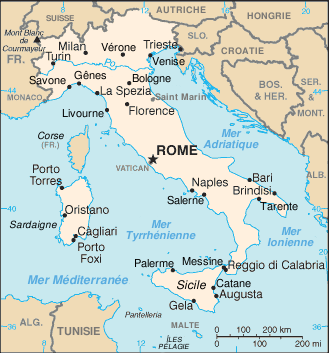
Italy
At the age of 17 he decided to fend for himself. He found an accommodation which he shared with his friend Henri Mignan, also a painter. He worked in the Louvre’s restoration workshop, and then worked at restoring paintings at the Palace of Versailles. Thus he was able to set some money aside.
Just before he turned twenty he decided, along with his childhood friend, to break their common piggy-bank dedicated to finance a journey; surprised by the amount of money they had managed to set aside in a few months they decided they would be able to make their dream come true: discovering Italy.
After a rather exhausting few weeks’ journey, they finally reached Rome, and then the Italian countryside. While discovering the magnificent landscapes, Charles-François Daubigny reinforced his desire to become a landscape painter. For several months they travelled through the countryside, spent time in the Italian museums and worked relentlessly. Then the time to return arrived as the kitty had almost totally disappeared. They backpacked for two months back to Paris. During their walk back, Daubigny discovered new landscapes, more specifically mountains.
Back in Paris Charles-François Daubigny managed to live pretty well, thanks to the numerous illustrations he had made for newspapers, and even in books including textbooks. With his brother-in-law and his friend Victor Geoffroy-Dechaume, silversmith and sculptor, they created a kind of association and pooled their resources.
Just before he turned twenty he decided, along with his childhood friend, to break their common piggy-bank dedicated to finance a journey; surprised by the amount of money they had managed to set aside in a few months they decided they would be able to make their dream come true: discovering Italy.
After a rather exhausting few weeks’ journey, they finally reached Rome, and then the Italian countryside. While discovering the magnificent landscapes, Charles-François Daubigny reinforced his desire to become a landscape painter. For several months they travelled through the countryside, spent time in the Italian museums and worked relentlessly. Then the time to return arrived as the kitty had almost totally disappeared. They backpacked for two months back to Paris. During their walk back, Daubigny discovered new landscapes, more specifically mountains.
Back in Paris Charles-François Daubigny managed to live pretty well, thanks to the numerous illustrations he had made for newspapers, and even in books including textbooks. With his brother-in-law and his friend Victor Geoffroy-Dechaume, silversmith and sculptor, they created a kind of association and pooled their resources.
The emergence of the artist
Soon after turning 20, he exhibited a painting “View of Paris and Saint-Louis Island” along with his father at the 1838 Salon. Then he started etching. Six of his works were exhibited at the Salon.
Although having already moved to something different from classicism thanks to his experience painting on location, Charles François Daubigny attended the School of Fine Arts and studied in Paul Delaroche’s studio, around 1841. This was in preparation for the Prix de Rome. Charles François managed to reach the final round. Unfortunately he was disqualified because of a missed administrative appointment, while having lunch with a friend...
Charles François Daubigny exhibited etchings at the 1841 and 1845 Salons, which gained him a reputation as an engraver.
In 1842, he married Marie-Sophie. Cécile, their daughter, was born one year later. The family settled in Fontainebleau and Charles François was able to work surrounded by nature. He was close to Barbizon, famous for its school, and went there often. With his friends he enjoyed installing his easel between the forest and the river. Nicknamed “the water painter”, rivers and ponds were an important part of his work and finally became the main component. He also found this atmosphere around Valmondois, so he went there more often, as it was closer to Paris, where he still had his studio.
Although having already moved to something different from classicism thanks to his experience painting on location, Charles François Daubigny attended the School of Fine Arts and studied in Paul Delaroche’s studio, around 1841. This was in preparation for the Prix de Rome. Charles François managed to reach the final round. Unfortunately he was disqualified because of a missed administrative appointment, while having lunch with a friend...
Charles François Daubigny exhibited etchings at the 1841 and 1845 Salons, which gained him a reputation as an engraver.
In 1842, he married Marie-Sophie. Cécile, their daughter, was born one year later. The family settled in Fontainebleau and Charles François was able to work surrounded by nature. He was close to Barbizon, famous for its school, and went there often. With his friends he enjoyed installing his easel between the forest and the river. Nicknamed “the water painter”, rivers and ponds were an important part of his work and finally became the main component. He also found this atmosphere around Valmondois, so he went there more often, as it was closer to Paris, where he still had his studio.
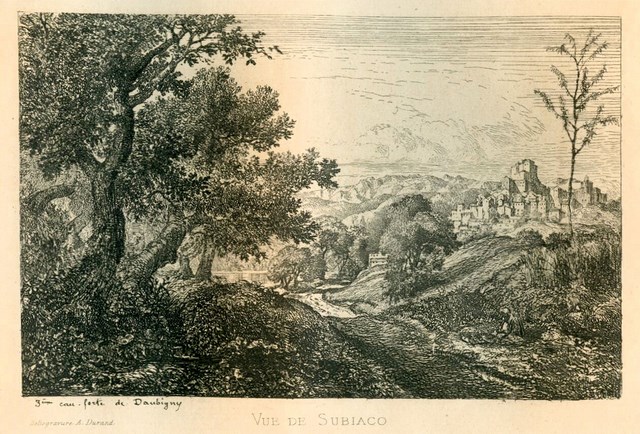
Etching : Subiaco view - 60 km Est of Rome
A recognized artist
.jpg)
The harvest- Orsay Museum - Paris - France
In 1846, their second child Charles Pierre was born. He was nicknamed Karl, to avoid confusion with his father.
In 1848 , Charles François won a second-class medal for one of his paintings exhibited at the Salon. The first class medals went to Corot and Delacroix.
Then he received his first order from the government: an etching. A few years later, in 1852, as he attracted more and more attention at the Salon, the government bought two of his paintings. One of them, "The Harvest" is now at the Orsay Museum, in Paris.
Charles François Daubigny then met Corot by chance. He knew him only through his work. The connection between the two was immediate, although Corot was 20 years older.
In 1853 Charles François and Marie-Sophie had their third child, Bernard.
With his several awards and medals Charles Francois saw his work becoming more and more appreciated. But it was also challenged by some critics who found the paintings to be merely “rough drafts”.
In 1848 , Charles François won a second-class medal for one of his paintings exhibited at the Salon. The first class medals went to Corot and Delacroix.
Then he received his first order from the government: an etching. A few years later, in 1852, as he attracted more and more attention at the Salon, the government bought two of his paintings. One of them, "The Harvest" is now at the Orsay Museum, in Paris.
Charles François Daubigny then met Corot by chance. He knew him only through his work. The connection between the two was immediate, although Corot was 20 years older.
In 1853 Charles François and Marie-Sophie had their third child, Bernard.
With his several awards and medals Charles Francois saw his work becoming more and more appreciated. But it was also challenged by some critics who found the paintings to be merely “rough drafts”.
The Studio Boat
In 1857, in order to be even closer to his subject and to the water he loved to represent, Daubigny bought a boat, which once served as a ferry : the “Botin”. He had a cabin installed, to provide shelter in case of bad weather, and if necessary to sleep. This became his Studio Boat *.
Every summer, he went to Auvers-sur-Oise, a peaceful village close to Valmondois, where he had spent part of his childhood. The Vaux Island became his main homeport. With the “Botin” he sailed on the rivers and even went up to Honfleur. Karl, the “ship’s boy” would accompany him. Then, after several stays on the “Côte Fleurie” in Normandy, he decided to return to Auvers-sur-Oise to settle.
His fame increased and Napoléon III purchased his “The Pond at Gylieu" , a canvas considered to be a genuine masterpiece. This was in 1860.
*several years later, in 1873, Monet borrowed this idea from Daubigny and had a Boat fitted out for painting.
Every summer, he went to Auvers-sur-Oise, a peaceful village close to Valmondois, where he had spent part of his childhood. The Vaux Island became his main homeport. With the “Botin” he sailed on the rivers and even went up to Honfleur. Karl, the “ship’s boy” would accompany him. Then, after several stays on the “Côte Fleurie” in Normandy, he decided to return to Auvers-sur-Oise to settle.
His fame increased and Napoléon III purchased his “The Pond at Gylieu" , a canvas considered to be a genuine masterpiece. This was in 1860.
*several years later, in 1873, Monet borrowed this idea from Daubigny and had a Boat fitted out for painting.
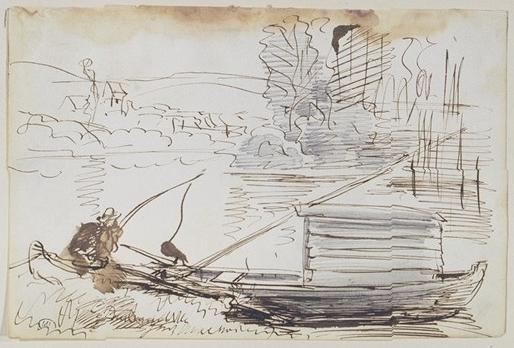
The Botin, sketch
The first artistic centre, in Auvers-sur-Oise
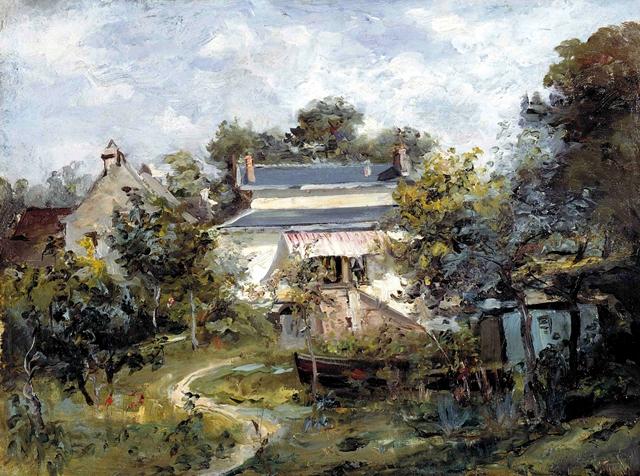
The Studio-House - Painted by Léonide Bourges - Private collection
The same year (1860) Charles François Daubigny bought a piece of land in Auvers to build his “studio in the countryside”. He was more and more interested by the interplay of light.
In 1861, the first artistic centre in Auvers-sur-Oise was built. Daubigny’s Studio House became a place to meet and work. Daubigny had several students.
Then, his close friends (Oudinot, Corot, Daumier, Geoffroy Dechaume …) managed to convince him to decorate this magical place, and everyone lent a hand. Corot, project manager of the Studio decoration, decided to represent the Italian landscapes he so loved.
Over time, the “Botin” started taking on water, had to be retired. It ended its life in the garden, as a bar and a shelter. It was then replaced by the “Bottin”, larger and better equipped for sailing. This new boat was ready to go in 1868*. At the same time Bernard became the boy’s boat whereas Karl was promoted Captain !
* The scale models of both boats were built by Daubigny’s descendant, Daniel Raskin. From time to time they are exhibited in Daubigny’s Studio House.
In 1861, the first artistic centre in Auvers-sur-Oise was built. Daubigny’s Studio House became a place to meet and work. Daubigny had several students.
Then, his close friends (Oudinot, Corot, Daumier, Geoffroy Dechaume …) managed to convince him to decorate this magical place, and everyone lent a hand. Corot, project manager of the Studio decoration, decided to represent the Italian landscapes he so loved.
Over time, the “Botin” started taking on water, had to be retired. It ended its life in the garden, as a bar and a shelter. It was then replaced by the “Bottin”, larger and better equipped for sailing. This new boat was ready to go in 1868*. At the same time Bernard became the boy’s boat whereas Karl was promoted Captain !
* The scale models of both boats were built by Daubigny’s descendant, Daniel Raskin. From time to time they are exhibited in Daubigny’s Studio House.
The new art defender, and the faithful friend
As early as 1866, Charles François Daubigny supported, along with his friend Corot, avant-garde artists, like Cézanne and Renoir. However he was not able to obtain their admission to the Salon. During this year, he travelled to London where he exhibited two paintings at the “Royal Academy”.
In 1868, Charles-François Daubigny managed to impose Monet, Pissarro, Renoir, Degas, Sisley and Berthe Morisot, angering the Commissioner for the Fine Arts. Monet and Sisley being refused for the 1869 and 1870 Salons, Daubigny, followed by his friend Corot, resigns from the board.
During the war of 1870 , Daubigny went to England. News was bad; the French artists who had taken refuge in London were in situations of hardship. By chance, Daubigny happened to meet Monet and helped him out.
Soon Pissarro found relief as well. Durand Ruel, the art dealer, managed to sell a few of his canvases. At the end of the 1870 war, Daubigny’s family returned to France staying at different locations before going back to Paris.
The Salon, which had stopped during the War, resumed and Daubigny exhibited two canvases and sold them. After a trip in Netherlands, in 1871, he warmly welcomed Monet and Pissarro to his home, in Auvers-sur-Oise, as well as other talented people, like Cézanne who arrived in Auvers in 1872.
In 1868, Charles-François Daubigny managed to impose Monet, Pissarro, Renoir, Degas, Sisley and Berthe Morisot, angering the Commissioner for the Fine Arts. Monet and Sisley being refused for the 1869 and 1870 Salons, Daubigny, followed by his friend Corot, resigns from the board.
During the war of 1870 , Daubigny went to England. News was bad; the French artists who had taken refuge in London were in situations of hardship. By chance, Daubigny happened to meet Monet and helped him out.
Soon Pissarro found relief as well. Durand Ruel, the art dealer, managed to sell a few of his canvases. At the end of the 1870 war, Daubigny’s family returned to France staying at different locations before going back to Paris.
The Salon, which had stopped during the War, resumed and Daubigny exhibited two canvases and sold them. After a trip in Netherlands, in 1871, he warmly welcomed Monet and Pissarro to his home, in Auvers-sur-Oise, as well as other talented people, like Cézanne who arrived in Auvers in 1872.
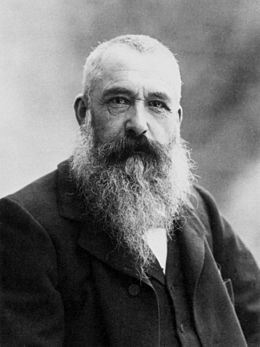
Claude Monet - Wikipedia
"Thanks to Daubigny and Durand Ruel several friends and I did not starve to death, on the London streets, in 1870: these are things we can’t forget"
Claude MONET, in a letter to Moreau Nélaton, 1924.
Claude MONET, in a letter to Moreau Nélaton, 1924.
The last years
.jpg)
The Snow, Orsay Museum - Paris - France
During the 1873 Salon, despite heavy criticism, Daubigny was awarded the Grand Prix for his painting “The Snow”, today owned by the Orsay Museum, in Paris. Similar criticism was leveled against the impressionists, several years later. Today, Daubigny is seen as a major pioneer of the impressionist movement.
“ … let me cite another canvas by Daubigny, The Snow, which was exhibited in 1872. We could not think of anything simpler, but at the same time larger. The fields are white with snow; a path crosses through, flanked on the left and on the right by gnarled branches of apple trees. And on this white mantle, on the fields and on the trees, a flock of crows has descended, black points, standing still and twirling. The whole of winter is here, in front of us. In my life, I have never seen anything more melancholic; Daubigny’s brush, delicate rather than powerful, has acquired an exceptional strength to render the bleak view of our plains, in December”
Emile Zola
“ … let me cite another canvas by Daubigny, The Snow, which was exhibited in 1872. We could not think of anything simpler, but at the same time larger. The fields are white with snow; a path crosses through, flanked on the left and on the right by gnarled branches of apple trees. And on this white mantle, on the fields and on the trees, a flock of crows has descended, black points, standing still and twirling. The whole of winter is here, in front of us. In my life, I have never seen anything more melancholic; Daubigny’s brush, delicate rather than powerful, has acquired an exceptional strength to render the bleak view of our plains, in December”
Emile Zola
His death
Over the years, his health declined. But he continued to escape aboard the “Bottin”. Back in Auvers-sur-Oise, he bought another house, opposite the station, but would never live there. Growing more and more tired, he started a new cruise along with his two sons, towards Rouen. He returned to Auvers, close to his friends, and as they entered winter, he worked in his studio, in Paris. He died on February 19th 1878 of a heart attack. He was buried in the Père Lachaise Cemetery, in Paris, close to Corot, his friend forever. Geoffroy-Dechaume carved his bust in marble, and this sculpture still decorates Daubigny’s grave. Daumier is not far from them. They had expressed the desire of being buried close to each other, in order to be able to continue laughing together …
"Uncle told me Daubigny is dead. This hurt me, I’m not ashamed to admit, … it must be a good thing, while dying, to be conscious of having done really good things, to know that, because of this we will remain alive in at least a few people’s memories, and to leave a good example to those who follow us"
Vincent Van GOGH, in a letter to Théo, 1878.
Vincent Van GOGH, in a letter to Théo, 1878.
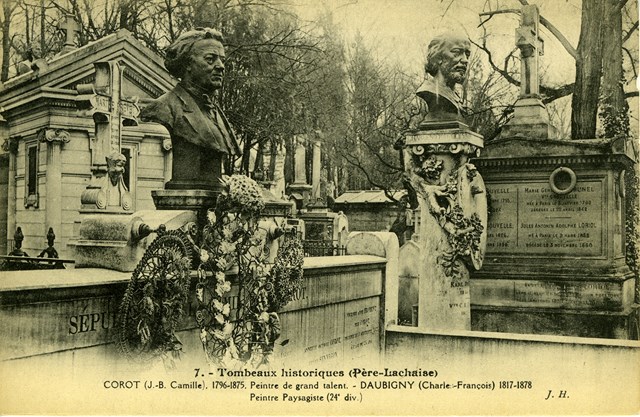
Daubigny's vault (right hand side) , next to Corot. Père Lachaise cemtery - Paris - France


